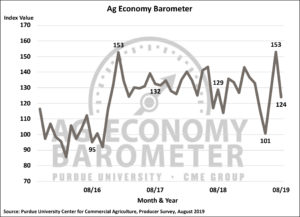Ag barometer declines sharply as commodity prices weaken; majority of farmers expect MFP payments in 2020

Ag Barometer Declines Sharply as Commodity Prices Weaken. (Purdue/CME Group Ag Economy Barometer/James Mintert)
WEST LAFAYETTE, Ind. and CHICAGO – The Purdue University/CME Group Ag Economy Barometer weakened significantly in August to a reading of 124, down 29 points from July. The barometer is based on a mid-month survey of 400 agricultural producers across the U.S. and was conducted between August 12 and August 20, 2019, with nearly all of the responses collected following USDA’s release of the August 12 Crop Production report.
Farmers’ expectations for both current and future economic conditions also took a tumble. The Index of Current Conditions dropped 19 points and the Index of Future Expectations dropped 34 points in August, both compared to a month earlier.
“Sharp declines in most commodity prices during July and early August weighed heavily on farmer sentiment this month,” said James Mintert, the barometer’s principal investigator and director of Purdue University’s Center for Commercial Agriculture. “While USDA’s announcement of the Market Facilitation Program (MFP) payment rates did help alleviate concerns about 2019 income for many famers, the big decline in the Index of Future Expectations indicates farmers’ are becoming more concerned about the future for U.S. agriculture and their farms.”
In late July, USDA announced the per planted acre payment rates by county for the 2019 MFP, with payments to be made in three tranches. To learn farmers’ views regarding the MFP payments, two questions were posited on the August survey: first, to what degree does $16 billion in MFP payments to U.S. farmers relieve their concerns about the impact of tariffs on their 2019 farm income; and second, in a follow-up question, do respondents expect USDA to provide payments to U.S. farmers for the 2020 crop year.
Over two-thirds (71 percent) of respondents stated that they feel the 2019 MFP program will either “completely or somewhat relieve” their concerns about tariffs’ impact on 2019 farm income. However, at the same time, nearly three out of ten respondents (29 percent) said “not at all,” indicating that a significant minority of farmers feel the MFP payments fall short of making up for income losses attributable to the ongoing tariff battles. When looking ahead to 2020, 58 percent of farmers in the August survey said they expect another MFP payment to be made to U.S. farmers for the 2020 crop year, suggesting a majority of farmers are counting on payments from USDA helping to make up future income shortfalls.
Since March 2019, questions were added to the survey to assess farmers’ perspectives on how quickly they expect the soybean trade dispute with China to be resolved and whether the resolution will benefit U.S. agriculture. During that time, farmers were almost evenly spit on this issue with 55 percent indicating they felt it was unlikely, and 45 percent saying it was likely to be resolved quickly.
In subsequent months, the percentage of farmers saying they think it is unlikely that the trade dispute will be resolved soon increased, ranging from a high of 80 percent in May to a low of 68 percent in June.
In August, there was a modest sentiment shift as the percentage of producers expecting resolution soon rose to 29 percent from 22 percent in July and the percentage of producers who felt resolution soon was unlikely declined to 71 percent from 78 percent in July.
When farmers were asked whether they think the trade dispute will ultimately be resolved in a way that benefits U.S. agriculture, the results have been mixed over time. In March, over three-fourths (77 percent) of farmers in the survey said they expect a beneficial outcome to the trade dispute; however, that percentage declined in May to 65 percent before rebounding in July to 78 percent. In August, despite the decline, the percentage of farmers who expect a positive outcome to the dispute for U.S. agriculture slipped to 72 percent.
Read the full August Ag Economy Barometer report at https://purdue.ag/agbarometer. This month’s report includes insights into whether producers feel now is a good or bad time to make large investments in their farming operations and their expectations for farmland values. The site also offers additional resources – such as past reports, charts and survey methodology – and a form to sign up for monthly barometer email updates and webinars. Each month, Purdue Center for Commercial Agricultural Director James Mintert provides a short video analysis of the barometer results, available at https://purdue.ag/barometervideo.
The Ag Economy Barometer, Index of Current Conditions and Index of Future Expectations are available on the Bloomberg Terminal under the following ticker symbols: AGECBARO, AGECCURC and AGECFTEX.
About the Purdue University Center for Commercial Agriculture
The Center for Commercial Agriculture was founded in 2011 to provide professional development and educational programs for farmers. Housed within Purdue University’s Department of Agricultural Economics, the center’s faculty and staff develop and execute research and educational programs that address the different needs of managing in today’s business environment.
About CME Group
As the world’s leading and most diverse derivatives marketplace, CME Group (www.cmegroup.com) enables clients to trade futures, options, cash and OTC markets, optimize portfolios, and analyze data – empowering market participants worldwide to efficiently manage risk and capture opportunities. CME Group exchanges offer the widest range of global benchmark products across all major asset classes based on interest rates, equity indexes, foreign exchange, energy, agricultural products and metals. The company offers futures and options on futures trading through the CME Globex® platform, fixed income trading via BrokerTec and foreign exchange trading on the EBS platform. In addition, it operates one of the world’s leading central counterparty clearing providers, CME Clearing. With a range of pre- and post-trade products and services underpinning the entire lifecycle of a trade, CME Group also offers optimization and reconciliation services through TriOptima, and trade processing services through Traiana.
CME Group, the Globe logo, CME, Chicago Mercantile Exchange, Globex, and E-mini are trademarks of Chicago Mercantile Exchange Inc. CBOT and Chicago Board of Trade are trademarks of Board of Trade of the City of Chicago, Inc. NYMEX, New York Mercantile Exchange and ClearPort are trademarks of New York Mercantile Exchange, Inc. COMEX is a trademark of Commodity Exchange, Inc. BrokerTec, EBS, TriOptima, and Traiana are trademarks of BrokerTec Europe LTD, EBS Group LTD, TriOptima AB, and Traiana, Inc., respectively. Dow Jones, Dow Jones Industrial Average, S&P 500, and S&P are service and/or trademarks of Dow Jones Trademark Holdings LLC, Standard & Poor’s Financial Services LLC and S&P/Dow Jones Indices LLC, as the case may be, and have been licensed for use by Chicago Mercantile Exchange Inc. All other trademarks are the property of their respective owners.
Writer: Kami Goodwin, 765-494-6999, kami@purdue.edu
Source: Jim Mintert, 765-494-7004, jmintert@purdue.edu
Media Contacts:
Aissa Good, Purdue University, 765-496-3884, aissa@purdue.edu
Matt Stroud, CME Group, 312-561-2269, matthew.stroud@cmegroup.com
Related website:
Purdue University Center for Commercial Agriculture: http://purdue.edu/commercialag
CME Group: http://www.cmegroup.com/
Photo Caption: Ag Barometer Declines Sharply as Commodity Prices Weaken. (Purdue/CME Group Ag Economy Barometer/James Mintert)
A publication-quality photo is available at https://news.uns.purdue.edu/images/2019/august-barometer.jpg


